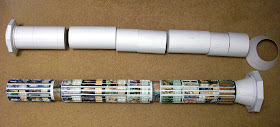This spring's project was an M136 AT-4. This piece accompanies Morning Rescue as a set. The goal was to have a rocket launcher that can store items inside, possibly one's lunch during the convention it would be used at. As a result, this program was called a Rocket Luncher, or Morning Breakfast. The launcher was designed for easy transport in mind and ease of assembly: the launcher was a commissioned piece that needed to be mailed out in a relatively nondescript box. I therefore designed the tube to be assembled from three shippable sections that fit in a fairly short box.
Morning Breakfast started off life as a three inch diameter $7 mailing tube from Office Depot. The tube was sized, then cut down to three sections for easy mailing. The center solid bands are simple connections between the sections. The required diameter was at least 92mm per my estimates, which required me to expand the outer diameter from 78mm. A liberal arrangement of triangular supports made of Magic cards were placed all around the circumference, supporting a four thickness shell of 110lb cardstock which would serve as the actual outer shell. The shells were made in segments where I could attempt to hide the seams with attachment straps.
The project was designed to replicate as many of the features of the AT-4 in storage and ready to fire conditions. The goal was to add folding sights, cocking lever, safety and firing switches. The main issue was the lack of decent reference material, as I have no actual model to copy the dimensions from and the photos out there are questionable at best for scaling.
The folding sights were difficult to approximate dimensions for. I did manage to find an expired auction listing intact spare sights that I could easily copy the dimensions for. The center aperature on the rear sights are 2mm and 7mm per the manual I found circulated, which allowed me to determine the remainder of the dimensions. These were liberally constructed with Magic cards and some stiffened tubes with super glue and 110lb cardstock.
The sights fold neatly between the storage compartment's rails, which would eventually be protected by a slip cover. The rails were stiffened by bamboo sticks, so they would not shear apart during use. The front sight is approximately the same as this assembly, but with smaller pins for retaining the sights.
The housing for the firing lever was the most difficult to replicate. My approximations are sufficient, but could be done better if I had access to a real copy. The parts were freehanded, then transferred to a template which I could then shape and minimize seams.
The shutters for the sights were simplified to reduce the amount of work required; the curves were approximated with straight edges that I smoothed (not really) out. The rail was stiffened with a trimmed bamboo stick approximately 2mm wide. The shutter was made of an upper and lower half, both stiffened with a healthy heap of Magic cards. Both were sandwiched together afterwards.
After both shutters were built, the details were done with laminated 110lb cardstock. The letters were crudely drawn and cut, so the (useless) instructions on the covers would stick out after a coat of paint. One sloppy test coat later, and the results were mediocre.
The shoulder rest was another element that was difficult to approximate dimensions for, until I realized that the lines match with specific portions of the octagonal muzzle cover and ends. That made copying it easy. It started off as a hollow 110lb cardstock shell, reinforced with two layers of Magic cards, then an array of 110lb cardstock tubes so it would not collapse when subjected to any force. The strap was made using a cheap wire picture frame I found at a Wal-Mart, and secured with a nylon webbing with a Size 24 snap fastener.
After a vigorous painting, I secured the elements in place with straps, approximately how they'd be on a real AT-4. Whether I did that remotely close to the real model is anyone's guess.
The rear exhaust port still has the end cap from the mailing tube in place for storage. I didn't bother painting that black to mask it. The safety pin was made from a paper clip. All the bolts on the end section are actual bolts, adding a bit of weight to the overall model, but were easier to buy than build approximations for.
The springs for the red safety lever and the folding sights were taken from some hair clips bought at a dollar store, and bent to fit. As a result, the safety lever can be held down, and the flip up sights actually flip up.
Pulling the sight covers back (and ignoring the instructions to "Press" ), the sights pop up.
The cocking lever slides somewhat freely, and the firing switch is spring loaded to allow for maniacal button pressing.
The overall costs for developing and building the AT-4 were fairly low, but annoying. The plans are not refined, and therefore will not be shared unless there's enough demand for it (which from this blog, means they'll never be released). I don't plan to label the launcher, as this needs to be shipped out fairly soon and I'd need to design all the graphics for the instructions with my mediocre graphics processing skills.













